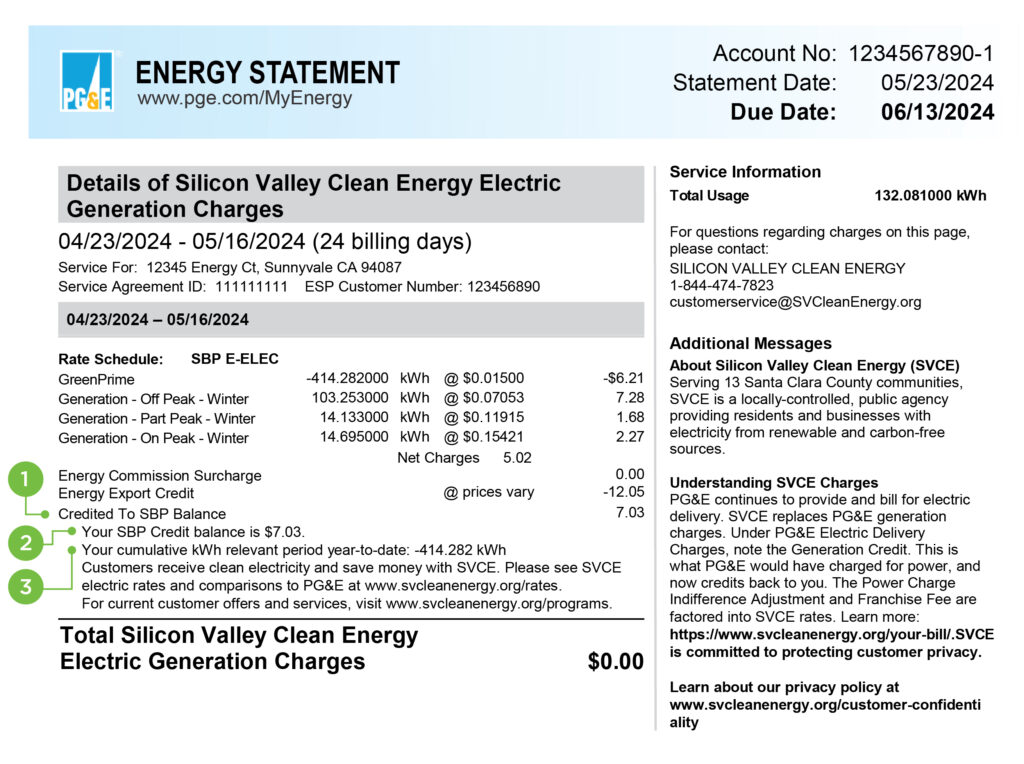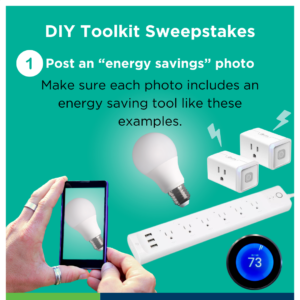Introducing Solar Billing Plan
All customers approved for solar installation after April 14, 2023 will be enrolled in the new Solar Billing Plan (aka Net Billing Tariff or NEM3.0). Under this new solar net metering plan, customers are credited for the electricity they export based on its value to the grid. The California Public Utility Commission (CPUC) made these changes to promote grid reliability, incentivize home battery storage, and help control electricity costs for all Californians in an equitable manner. For customers approved between April 15, 2023 and April 15, 2024, billing under this new arrangement began on the customer’s first true-up date.
How Solar Billing Plan Works
As a SBP customer, you will be automatically enrolled in the Electric Home rate. Your meter tracks the difference between the amount of electricity your solar panels produce and the amount of electricity you use during each billing cycle. When your panels produce more electricity than you use, you will receive Energy Export Credits for your surplus electricity. These credits reflect the value of your power to the grid at the specific time it was exported. The credit level will vary by time of day, day of the week, and season.
SVCE generation charges will be settled within your monthly bill and PG&E’s transmission and delivery service charges will be settled during PG&E’s annual true-up process. If you produce more electricity than you consume on a monthly basis, any excess export credit will be rolled forward to the following month (shown as SBP Credit Balances on your bill).
If you produce more electricity than you consume on an annual basis, you may receive an automatic cashout from SVCE each spring. A cashout worth $100 or more, up to a maximum of $5,000, will be provided via check. A cashout worth less than $100 will be provided as a bill credit. At the end of SVCE’s cashout cycle, all SBP Credit Balances and kWh balances are reset.
SVCE pays the PG&E net surplus compensation rate (NSC rate) for cumulative kWh produced. SBP customers are subject to additional conditions for compensation as described by the PG&E Electric Schedule NBT.
SVCE Solar Billing Plan Program Benefits

Get Paid for Excess Solar Generation
If you produce more electricity than you consume on an annual basis, SVCE pays twice the PG&E net surplus compensation rate per kWh for any excess solar you produce and put back onto the grid. PG&E’s NSC rate is based on current market prices and varies from year to year. Income-qualified customers will receive additional compensation with a pricing 2.5 times the NSC rate per kilowatt-hour. After the Spring 2025 cashout, SVCE will pay customers the NSC rate for excess solar generated annually, and two-and-a-half (2.5) times the NSC rate for income-qualified customers (CARE/FERA participants).

Monthly Billing with Credit Roll Over
We bill you monthly so you don’t end up with a year’s worth of charges in an annual true-up. Excess credits rollover month-to-month.

Automatic Annual Cashout
SVCE automatically pays you each spring for the excess solar energy you produced. A cashout worth $100 or more, up to a maximum of $5,000, will be provided via check. A cashout worth less than $100 will be provided as a bill credit.

Opportunity to Enroll in GreenPrime
Unlike with PG&E, SVCE SBP customers can rest assured that that when they do need additional electricity, it’s sourced with 100% renewable energy—at an additional cost of $0.017/kWh.

Additional GreenPrime Value for Surplus Generation
Excess solar produced each month for GreenPrime customers is valued at an additional $0.017 per kWh in the monthly credit rollover. For the annual cashout, GreenPrime is valued the same as GreenStart.
Energy Export & Bonus Credits
The Export Credit rates are determined through a public proceeding managed by the CPUC. Currently, the export rate ranges from two cents to over two dollars per kWh based on the month and time of day.
Depending on the year and circumstances of your solar installation, you may also be eligible for additional bonus credits. Customers enrolled in the California Alternate Rates for Energy (CARE) and Family Electric Rate Assistance (FERA) programs or residing in a disadvantaged community or Indian Country will receive a higher credit value.
You can find more information and download a complete list of export rates on PG&E’s website.
Additonal Benefits with Battery Storage
- The CPUC estimates that the average residential customer could achieve significant savings on their energy bill through paired solar and battery installation.
- The Inflation Reduction Act increased the federal tax credit for solar systems to 30% and now includes a 30% credit for battery storage.
- Explore battery storage options through the Battery Assistant. The Battery Assistant is a no-obligation, end-to-end concierge service designed to help you independently compare pricing from multiple installers and access financing options.
SBP Sample Bill
As an SVCE Solar Billing Plan customer, you will see an SBP-related line item on the SVCE Electric Generation Charges page of your monthly energy bill. You’ll find details about the non-SBP charges in Understanding Your Bill.

1
Credited/Charged to SBP Balance
A new line is added to your billing statement indicating accrued generation credits called “Credited/Charged to NEM/SBP Balance.” This is how much is added or subtracted from your existing NEM/SBP Balance, if any.
2
Your SBP Credit Balance is $XX.XX
This is your credit balance which will be applied to future months. If you do not have a credit balance, your bill will read: “Your SBP Balance Owed is $0.00”
3
Your cumulative kWh relevant period year-to-date
This tracks your net production or net consumption of electricity for the year and resets at
the beginning of your April billing cycle. If you are a net producer on an annual basis, it is
used to calculate your SVCE cashout.
How To Enroll
Current SBP Customers. If you’re already enrolled in PG&E’s SBP program and you switch to SVCE, you will automatically be enrolled in SVCE’s SBP program—no action is necessary. Both PG&E and SVCE will perform a settlement of your account’s net charges and credits (known as a “true-up”) when your energy provider changes to SVCE or back to PG&E. This settlement will result in a balance due for any usage charges owed to-date, or alternatively will result in a forfeiture of any excess credits on your account at that time.
New SBP Customers. SVCE customers sign up for the SBP program as usual, through PG&E. You will then be automatically served by SVCE’s SBP program.
PG&E is required to complete the SBP interconnection within 30 working days of receiving an application. If you don’t currently have an installed electric generation system, we recommend you first contact a solar or other energy system installer, or a professional who can guide you through installing a system and submitting a SBP application.
PG&E will provide final permission to operate your solar PV system and/or wind system, whether or not you are an SVCE customer. PG&E will review your completed application, along with a single-line diagram that is representative of your system. Upon a successful evaluation of your engineering review, PG&E will install your bi-directional meter. You may operate your PV system following receipt of a “Permission to Operate” letter.



